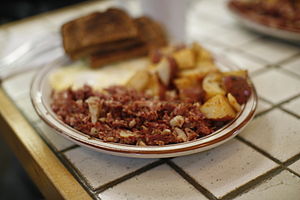 |
| An order of corned beef hash. |
In many locations, hash is served primarily as a breakfast food on restaurant menus and as home cuisine, often served with eggs and toast (or biscuits), and occasionally fried potatoes (hash browns, home fries, etc.). The dish may also use corned beef or roast beef.
Corned beef hash became especially popular in some countries during and after World War II as rationing limited the availability of fresh meat.
Hash has recently made a comeback as more than just a dish for leftovers or breakfasts of last resort. High-end restaurants now offer sophisticated hashes and the first cookbook dedicated exclusively to a wide variety of hashes was self-published in 2012.
In Northern England, corned beef hash is a traditional cheap and quick dish dating back many years. Corned beef (beef treated with saltpeter) is nearly always from a tin and almost always imported from South America. Tinned corned beef was available more plentifully during war years (when fresh meat was heavily rationed) and a staple food in the armed forces. The meal is made with tinned corned beef, stirred with browned onions, before having liquid added (either gravy or stock, or tinned tomatoes) then having lightly boiled sliced potatoes layered over the top before being browned under a hot grill. Alternatively cubed boiled potatoes are stirred in. Some recipes would add peas or carrots.[citation needed]
In Scotland, the dish of "stovies" is very similar to hash. There are many variations on the dish, but all consist of a base of mashed or coarsely chopped potato, with onions and leftover meat, usually minced or roast beef although there are many variations including corned beef.
The meat packing company Hormel claims that it introduced corned beef hash and roast beef hash to the
 |
| Texas hash with cornbread and green beans |
Alternatively, in the southern United States, the term "hash" may refer to two dishes:
* a Southern traditional blend of leftover pork from a barbecue mixed with barbecue sauce and served over rice. This is a common side dish at barbecue restaurants and pig pickin's notably in South Carolina and Georgia.
* a thick stew made up of pork, chicken and beef, generally leftover, traditionally seasoned with salt and pepper and other spices, reduced overnight over an open flame in an iron washpot or hashpot.
* Some areas in the south also use the term hash to refer to meat, such as wild game, that is served as BBQ or Pulled meat that is boiled first.
* In Denmark, hash is known in Danish as "biksemad" (roughly translated, "tossed together food"), and it is a traditional leftover dish usually served with a fried egg, worcestershire sauce, pickled red beet slices and ketchup or Bearnaise sauce. The meat is usually pork, and the mixture is not mashed together into a paste, but rather the ingredients are coarsely diced and readily discernible in its cooked form.
* In Sweden, there is a version of hash called pyttipanna[8] and in Finland, pyttipannu, and Norway, pyttipanne. It is similar to the Danish version. The Swedish variety Pytt Bellman calls specifically for beef instead of other meats and adding cream to the hash. It is named after Sweden's 18th century national poet Carl Michael Bellman.
* In Austria and perhaps more specifically Tyrol, there exists a similar dish called "Gröstl", usually consisting of chopped leftover meats (often being pork sausage), potato and onions fried with herbs (typically marjoram and parsley) and then served topped with a fried egg.
* In Malaysia, a similar dish is called "bergedil". It is usually made with minced meat, potatoes, and onions, fried until brown.
* In Ibero-American (Spanish, Portuguese and Latin American) cuisines, there is a similar dish called picadillo (Spanish) or carne moída (Portuguese). It is made with ground meat (usually beef), tomatoes (tomato sauce may be used as a substitute), vegetables and spices[9] that vary by region (the Portuguese and Brazilian version is generally carne moída refogada, very heavy on garlic, in the form of an aioli sofrito called refogado, and often also heavy on onion and bell peppers). It is often served with rice (it can be fried in aioli sofrito if those who will eat have a strong fondness for garlic), as well as okra, in the form of quiabo refogado—okra fried in an aioli sofrito, just as the hash itself and the collard greens used in feijoada—, in Brazil, there constituting a staple) or used as a filling in dishes such as tacos, tostadas, or as a regular breakfast hash with eggs and tortillas (not in Brazil and Portugal). In Brazil and Portugal, it is used as bolognese sauce for pasta, and also used as a filling for pancake rolls, pastel (Brazilian pastry empanada), empadão and others (not with okra as it is far too perishable to be used in a fill for fast food and its consumption together with wheat flour-based foods often does not fit cultural tastes). The name comes from the West Iberian (Spanish, Leonese and Portuguese) infinitive verb picar, which means "to mince" or "to chop".
* In Germany there is Labskaus.
Corned Beef Hash
Ingredients:
6 large potatoes, peeled and diced
1 (12 ounce) can corned beef, cut into
chunks
1 medium onion, chopped
1 cup beef broth
Directions:
1. In a large deep skillet, over medium heat, combine the potatoes, corned beef, onion, and beef broth. Cover and simmer until potatoes are of mashing consistency, and the liquid is almost gone. Mix well, and serve.
No comments:
Post a Comment